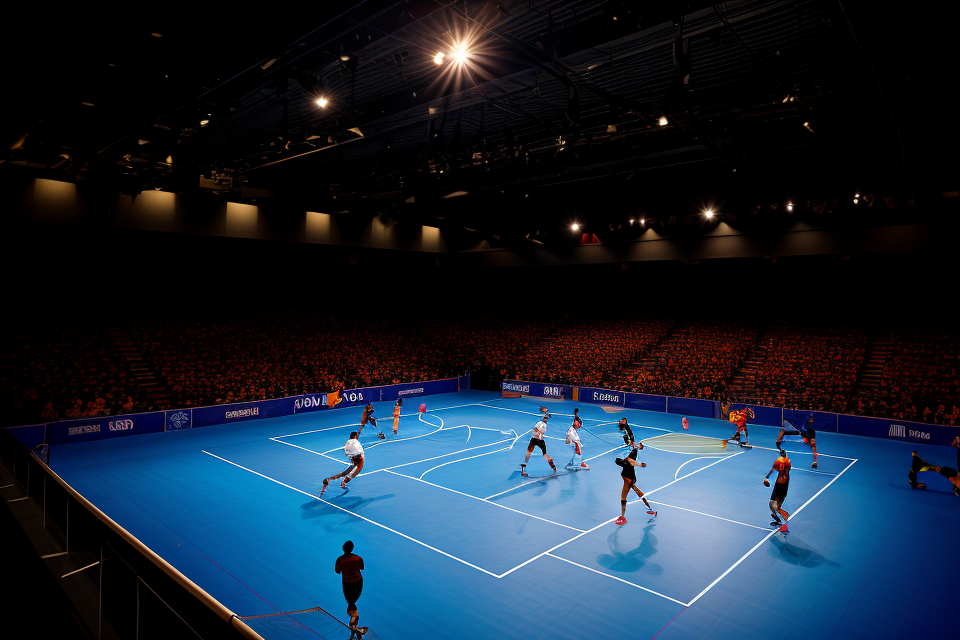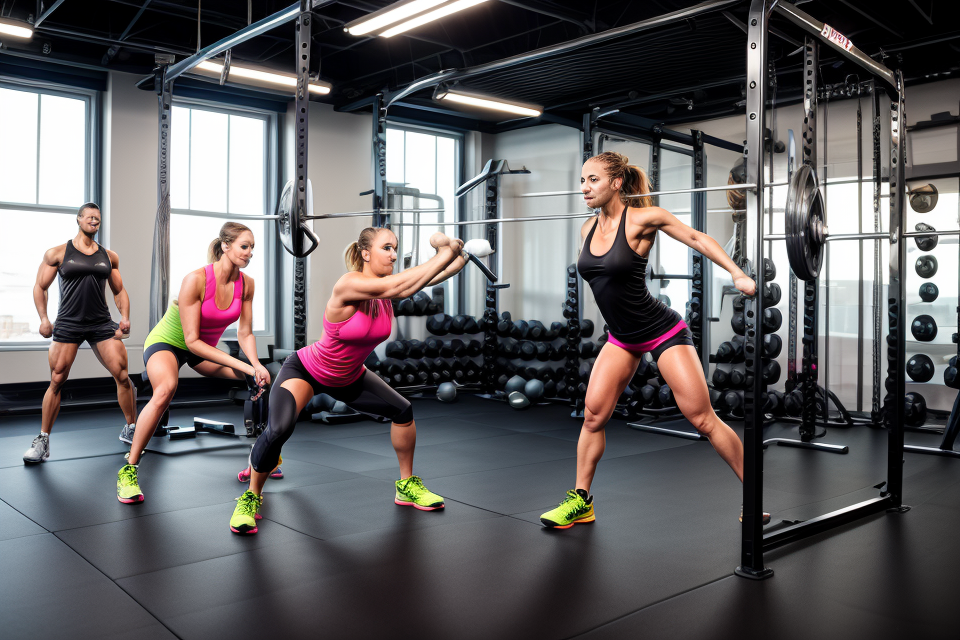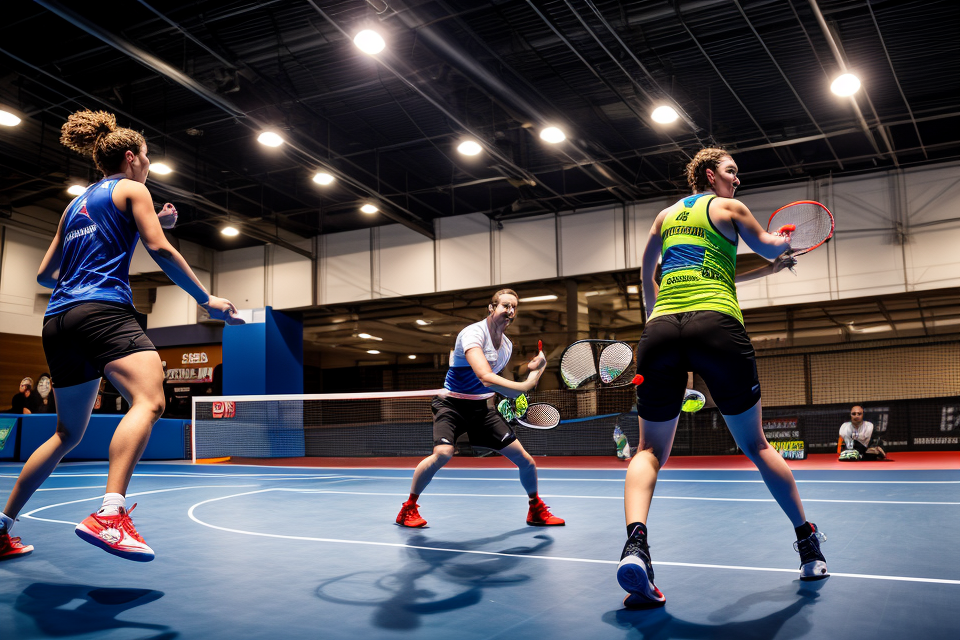Squash is a sport that demands physical fitness and mental prowess. It is played with a small, hollow rubber ball and a racquet. The game is fast-paced and can be played singles or doubles. Squash requires players to move quickly and change direction rapidly. The sport is known for its high intensity and physical demands. Some people believe that squash is the most physically demanding sport, but is this really true? In this article, we will explore the physical demands of squash and compare it to other sports to determine if it truly deserves the title of the most physically demanding sport.
Squash is often considered one of the most physically demanding sports due to its high-intensity nature and the physical requirements it places on players. It involves constant movement, rapid changes of direction, and explosive movements, making it a sport that requires excellent fitness levels. Players need to be highly conditioned to compete at a high level, and the physical demands of the sport can lead to injuries if players are not properly trained. The physical demands of squash include excellent hand-eye coordination, footwork, and agility, as well as a high level of endurance and strength. In addition, the small court size and fast-paced nature of the game mean that players must be able to quickly adapt to changing situations and maintain a high level of concentration throughout the match. Overall, while there may be other sports that also place high physical demands on players, squash is certainly one of the most physically challenging sports out there.
The Physical Demands of Squash
Cardiovascular Fitness
The Importance of Cardiovascular Fitness in Squash
In squash, cardiovascular fitness plays a crucial role in determining a player’s endurance, speed, and overall performance on the court. The game is highly aerobic, with players moving continuously throughout the match to cover the court and execute shots. The demands of squash on the cardiovascular system make it a sport that requires exceptional cardiovascular fitness.
How Squash Improves Cardiovascular Fitness
Squash is a sport that challenges the cardiovascular system in several ways, making it an effective workout for improving cardiovascular fitness. The sport requires players to perform repeated sprints, sudden stops, and changes in direction, all of which contribute to an increase in heart rate and the improvement of cardiovascular fitness.
Furthermore, squash is a high-intensity sport that requires players to maintain a high level of energy output throughout the match. This continuous exertion helps to increase the endurance of the cardiovascular system, leading to improved cardiovascular fitness over time.
In addition to its aerobic benefits, squash also improves anaerobic fitness, which is the ability of the body to perform high-intensity activities without the presence of oxygen. Squash involves short bursts of intense activity, such as sprinting to the ball or executing a powerful shot, which challenges the anaerobic system and improves its efficiency over time.
Overall, the physical demands of squash make it a sport that is highly effective for improving cardiovascular fitness. Whether you are a recreational or competitive player, engaging in regular squash activities can lead to significant improvements in cardiovascular health and overall fitness.
Strength and Power
The Importance of Strength and Power in Squash
Strength and power are crucial aspects of squash, as they enable players to execute powerful shots and maintain control over the ball during rallies. Players require a high level of strength and power in their legs, core, and upper body to generate the force necessary to hit the ball with precision and accuracy.
How to Train for Strength and Power in Squash
Training for strength and power in squash involves a combination of strength training exercises and court-specific drills. Some of the most effective exercises for improving strength and power in squash include:
- Resistance training: Using weights or resistance bands to strengthen muscles in the legs, core, and upper body.
- Plyometrics: Jump-based exercises that help improve power and explosiveness.
- Squat jumps: A plyometric exercise that involves jumping from a squat position to improve power in the legs.
- Medicine ball slams: A strength training exercise that involves slamming a medicine ball against a surface to improve power in the upper body.
In addition to these exercises, court-specific drills such as ladder drills, agility cones, and shadow drills can help improve footwork, agility, and coordination, which are essential for maintaining control over the ball during rallies.
It is important to note that strength and power training should be tailored to individual needs and abilities, and should be performed under the guidance of a qualified coach or fitness professional. Additionally, players should ensure that they are incorporating rest and recovery into their training regimen to avoid injury and maximize performance.
Speed and Agility
Squash is a sport that requires players to be quick on their feet and have excellent agility. This is because the court is small, and the ball can change direction quickly, making it essential for players to be able to move quickly and change direction quickly as well.
Speed and agility are crucial in squash because they allow players to get to the ball quickly and make shots that would otherwise be impossible. A player who is slow and lacking in agility will have difficulty keeping up with the pace of the game and will likely make mistakes.
To improve speed and agility in squash, players can do several drills and exercises. These may include sprints, agility drills, and plyometric exercises, which are designed to improve explosiveness and power. Additionally, players can work on their footwork and footwork drills to improve their ability to move quickly and change direction quickly.
In conclusion, speed and agility are crucial in squash, and players who want to improve their performance should focus on drills and exercises that will help them improve these skills. By doing so, they will be better equipped to keep up with the fast pace of the game and make shots that would otherwise be impossible.
Flexibility and Mobility
Flexibility and mobility are crucial components of physical fitness for squash players. These skills allow players to perform a wide range of movements, such as reaching for balls, moving quickly across the court, and changing direction abruptly. Additionally, flexibility and mobility help reduce the risk of injury and improve overall performance.
Here are some specific benefits of flexibility and mobility in squash:
- Increased reach and reachability: Good flexibility and mobility allow players to reach for balls that are farther away from them, which can help them win points and maintain control of the game.
- Quicker movement: Squash is a fast-paced sport that requires quick reactions and movements. Players who are flexible and mobile can move quickly and change direction abruptly, which can give them an advantage over their opponents.
- Reduced risk of injury: Tight muscles and poor flexibility can increase the risk of injury in squash. By maintaining good flexibility and mobility, players can reduce their risk of developing muscle strains, sprains, or other injuries.
To improve flexibility and mobility for squash, players can try the following stretches and exercises:
- Hamstring stretches: Hamstring stretches can help improve flexibility in the back of the legs, which is important for reaching and moving across the court. To perform a hamstring stretch, stand with your feet hip-width apart and reach forward, keeping your back straight.
- Hip flexor stretches: Tight hip flexors can limit mobility and cause discomfort in the hips and lower back. To stretch hip flexors, kneel on one knee and reach forward, keeping your back straight.
- Ankle stretches: Good ankle mobility is important for moving quickly and changing direction abruptly in squash. To stretch the ankles, stand facing a wall and lean forward, keeping your heels on the ground.
- Foam rolling: Foam rolling can help release tension in the muscles and improve flexibility. Try rolling out the legs, back, and arms before or after a squash match to improve flexibility and reduce the risk of injury.
By incorporating these stretches and exercises into their training routine, squash players can improve their flexibility and mobility, which can help them perform better on the court and reduce their risk of injury.
Endurance
The Importance of Endurance in Squash
Squash is a physically demanding sport that requires players to have a high level of endurance. Endurance is important in squash because it allows players to maintain a high level of intensity and physical output throughout the course of a match. The length of a squash match can vary, but typically ranges from 30 to 90 minutes, depending on the skill level of the players and the format of the match. Players must be able to sustain their physical effort and mental focus for the duration of the match to be successful.
How to Improve Endurance for Squash
Improving endurance for squash involves a combination of physical and mental training.
- Cardiovascular Training: Cardiovascular exercise, such as running, cycling, or swimming, is essential for building endurance. Players should aim to do at least 30 minutes of cardiovascular exercise at least three times per week.
- Strength Training: Strength training can help players build the muscular endurance needed to sustain physical effort throughout a match. Exercises such as weightlifting, resistance band workouts, and bodyweight exercises can all help build strength and endurance.
- Mental Training: Mental training is just as important as physical training when it comes to building endurance. Players should focus on developing their mental toughness and resilience, which will help them maintain their focus and physical output during a match. This can involve techniques such as visualization, mindfulness, and positive self-talk.
- Match Practice: Practicing match scenarios can help players build their endurance. Playing multiple sets in a row, or practicing drills that simulate the physical demands of a match, can help players develop the endurance needed to compete at a high level.
By incorporating these training methods into their routine, players can improve their endurance and increase their chances of success on the squash court.
Comparison with Other Sports
Basketball
Basketball is a sport that requires high levels of physical fitness and endurance. The game is played on a court with two teams of five players each, who attempt to score points by shooting a ball through a hoop.
Physical demands of basketball
Basketball is a sport that requires players to be physically fit and have excellent cardiovascular endurance. Players need to be able to run up and down the court quickly and efficiently, and they must be able to change direction rapidly. The game also requires players to have strong muscles in their legs, as they will be jumping, pivoting, and moving laterally throughout the game.
In addition to physical fitness, basketball players must also have excellent hand-eye coordination and be able to make quick decisions on the court. They must be able to pass the ball accurately and shoot it with precision.
Comparison of physical demands between squash and basketball
While both squash and basketball are physically demanding sports, there are some differences in the physical demands placed on players. Squash requires players to be highly fit and have excellent endurance, as the game is played on a small court and can be very fast-paced. Players must be able to move quickly and change direction rapidly, as well as have strong muscles in their legs and core.
Basketball, on the other hand, places more emphasis on the legs and lower body. Players must be able to jump and land safely, as well as make quick cuts and changes of direction. The game also requires players to have excellent hand-eye coordination and be able to make split-second decisions on the court.
Overall, both squash and basketball are highly physical sports that require a high level of fitness and endurance. However, the specific physical demands placed on players may differ depending on the sport.
Soccer
Soccer is a popular sport that requires high levels of physical fitness. It is played by two teams of 11 players each, and the objective is to score goals by kicking the ball into the opposing team’s net. The game is fast-paced and involves a lot of running, jumping, and kicking.
Physical demands of soccer
Soccer is a sport that requires a high level of physical fitness. Players need to be in excellent shape to perform at their best. The physical demands of soccer include:
- Running: Soccer players cover long distances during a match. They need to be able to run at high speeds, change direction quickly, and maintain their speed throughout the game.
- Jumping: Soccer players need to be able to jump high to head the ball, challenge for headers, and make tackles.
- Kicking: Soccer players need to have strong legs and be able to kick the ball with accuracy and power.
- Agility: Soccer players need to be agile and able to change direction quickly.
- Endurance: Soccer matches can last up to 90 minutes, and players need to be able to maintain their physical performance throughout the game.
Comparison of physical demands between squash and soccer
While both squash and soccer are physically demanding sports, there are some differences in the physical demands of each sport. Some of the differences include:
- Intensity: Soccer matches are longer and can last up to 90 minutes, while squash matches are usually shorter and can last up to 1 hour. However, the intensity of squash can be higher as players are constantly moving and have to be in top physical condition throughout the match.
- Aerobic capacity: Soccer requires a high level of aerobic capacity as players need to be able to run for long periods of time. Squash also requires a high level of aerobic capacity, but the intensity of the game means that players need to be able to perform at a high level for shorter periods of time.
- Explosiveness: Soccer requires players to be explosive and able to make sudden movements, such as sprinting and jumping. Squash also requires explosiveness, but players also need to be able to move quickly and change direction rapidly.
- Technical skills: Soccer requires technical skills such as dribbling, passing, and shooting. Squash also requires technical skills, but the game is more physically demanding as players need to be able to hit the ball with power and accuracy.
Overall, both squash and soccer are physically demanding sports that require a high level of fitness. While there are some differences in the physical demands of each sport, both require players to be in excellent shape to perform at their best.
Tennis
Tennis is a sport that requires a high level of physical fitness, coordination, and agility. The physical demands of tennis are significant, as players are required to move quickly and change direction rapidly. The sport involves a lot of running, jumping, and sudden stops, which can put a lot of strain on the body.
One of the most physically demanding aspects of tennis is the constant lateral movement. Players need to be able to move quickly and efficiently from side to side, and must have excellent footwork and coordination to hit the ball accurately. This requires a lot of strength and endurance in the legs, as well as good cardiovascular fitness.
In addition to the physical demands of the sport, tennis also requires a high level of mental toughness and strategic thinking. Players must be able to think quickly on their feet and make split-second decisions, as well as manage their energy levels and strategies throughout the match.
Compared to squash, tennis may require slightly less overall physical output, as there are more opportunities for players to catch their breath between points and games. However, the constant lateral movement and rapid changes of direction still make it a highly physically demanding sport.
The Benefits of Squash Fitness
Cardiovascular Health
Squash is a sport that requires players to move quickly and change direction frequently, making it an excellent workout for the cardiovascular system. The continuous running, jumping, and sudden stops involved in the game can significantly improve cardiovascular health.
How squash improves cardiovascular health
Squash is a high-intensity sport that demands excellent cardiovascular endurance. Players must be able to maintain a fast pace throughout the game, and this requires the heart to pump blood efficiently to the muscles. The continuous movement involved in squash helps to strengthen the heart and improve its efficiency, leading to better cardiovascular health.
Moreover, squash also improves the overall circulation of blood in the body. The constant movement and change of direction forces the blood to circulate more efficiently, leading to better oxygenation of the muscles and a more efficient energy expenditure. This, in turn, leads to improved cardiovascular health.
The benefits of improved cardiovascular health
Improved cardiovascular health is one of the most significant benefits of playing squash regularly. When the heart works more efficiently, it pumps blood more effectively, which can lead to lower blood pressure and a reduced risk of heart disease.
Additionally, better cardiovascular health can also lead to improved athletic performance. Since squash is a high-intensity sport, players who have better cardiovascular endurance will be better equipped to handle the physical demands of the game. This can lead to improved speed, endurance, and overall performance on the court.
Overall, squash is an excellent sport for improving cardiovascular health. Its high-intensity nature and continuous movement make it an effective workout for the heart and circulatory system, leading to better overall health and athletic performance.
Squash is a sport that demands high levels of strength and power from its players. It requires quick movements, rapid changes of direction, and powerful strikes. Playing squash regularly can help improve your strength and power in several ways.
How squash improves strength and power
Squash is a high-intensity sport that involves explosive movements such as jumping, sprinting, and striking the ball with great force. These movements require strength and power in the legs, core, and arms. As you play squash, your muscles adapt to the demands of the game, becoming stronger and more powerful over time.
Additionally, squash requires excellent footwork and agility, which can help improve your balance, coordination, and overall body control. This can help you move more efficiently on the court, allowing you to make quicker movements and cover more ground.
The benefits of improved strength and power
Improved strength and power can have numerous benefits for your overall health and fitness. Stronger muscles can help you perform daily tasks more easily, such as carrying groceries or lifting children. They can also help reduce your risk of injury and improve your athletic performance in other sports.
In addition to physical benefits, improved strength and power can also have mental health benefits. Exercise has been shown to reduce stress and anxiety, and playing squash can be a great way to relieve tension and boost your mood.
Overall, squash is a sport that can provide significant benefits for your strength and power. Whether you are a beginner or an experienced player, incorporating squash into your fitness routine can help you improve your overall health and fitness levels.
How squash improves speed and agility
Squash is a sport that requires players to be fast and agile in order to be successful. The nature of the game, which involves sprinting, changing direction quickly, and moving in all directions, makes it an excellent sport for improving speed and agility. The constant movement and the need to react quickly to the ball and your opponent’s movements are key factors in developing these physical attributes.
The benefits of improved speed and agility
Improved speed and agility can have a positive impact on a player’s performance in squash, as well as in other sports and in daily life. Faster players are able to cover more ground on the court, which can give them an advantage in terms of being able to get to the ball before their opponent. Agility, on the other hand, allows players to change direction quickly and move efficiently around the court, which can also be beneficial in terms of being able to get to the ball and make shots.
Additionally, the physical demands of squash can help improve overall cardiovascular fitness, which can have benefits for overall health and well-being. The sport can also help improve coordination and balance, which can be useful in other physical activities.
Overall, squash is a sport that requires players to be fast and agile, and these physical attributes can have a positive impact on performance in the sport, as well as in other areas of life.
How squash improves flexibility and mobility
Squash is a sport that requires quick movements and agility, which can improve the flexibility and mobility of the body. Players must be able to move in all directions and change direction rapidly. This requires a high level of flexibility in the joints and muscles, which can be improved through regular exercise and physical activity.
The benefits of improved flexibility and mobility
Improved flexibility and mobility can provide several benefits for players of any sport. In squash, it can help players to move more efficiently and effectively around the court, making it easier to hit shots and reach the ball. Additionally, improved flexibility can help to reduce the risk of injury, as it can increase the range of motion in the joints and muscles. This can be particularly important in a sport like squash, where players are constantly moving and changing direction.
Squash is a sport that demands a high level of physical fitness from its players. One of the key benefits of playing squash is the improvement in endurance that it provides. Endurance is the ability of the body to sustain physical activity for an extended period of time. Squash requires players to move continuously around the court, hitting the ball with power and accuracy, which makes it an excellent sport for improving endurance.
How Squash Improves Endurance
Squash is a fast-paced sport that requires players to be constantly moving. The physical demands of the game are high, and players need to be fit and agile to perform at their best. The continuous movement involved in squash means that players need to have a high level of cardiovascular fitness in order to sustain their performance over the course of a match.
The sport also requires players to be able to change direction quickly and move around the court with speed and agility. This means that squash is an excellent sport for improving endurance in the legs, as well as the cardiovascular system.
The Benefits of Improved Endurance
Improved endurance is one of the key benefits of playing squash. The physical demands of the game mean that players need to be fit and agile, and regular participation in the sport can help to improve endurance in a number of ways.
Firstly, improved endurance can help players to perform at their best during matches. By improving their cardiovascular fitness and leg strength, players can sustain their performance for longer periods of time, which can help them to win more matches.
Secondly, improved endurance can also help players to recover more quickly between points and games. This can help to reduce the risk of injury and fatigue, and can help players to maintain their performance levels throughout the course of a match.
Finally, improved endurance can also have a positive impact on overall health and wellbeing. Regular participation in squash can help to improve cardiovascular health, reduce the risk of obesity and other health conditions, and improve mental health and wellbeing.
In conclusion, squash is a sport that demands a high level of physical fitness from its players. Improved endurance is one of the key benefits of playing squash, and regular participation in the sport can help to improve cardiovascular fitness, leg strength, and overall health and wellbeing. Whether you are a competitive player or simply enjoy playing for fun, squash is an excellent sport for improving endurance and staying fit and healthy.
FAQs
1. What is squash?
Squash is a racket sport played by two players in a four-walled court. The game involves hitting a small, hollow rubber ball against a wall in such a way that your opponent is unable to return it.
2. What makes squash physically demanding?
Squash is physically demanding because it requires players to move quickly and change direction rapidly. The game also involves jumping, lunging, and sprinting, which can put a lot of strain on the body. Additionally, the high altitude and air pressure at sea level can make it difficult to breathe, adding to the physical demands of the sport.
3. What are some of the physical benefits of playing squash?
Playing squash can improve cardiovascular fitness, hand-eye coordination, and agility. It can also help to build strength and endurance in the legs, as well as improve flexibility and balance.
4. Is squash the most physically demanding sport?
It is difficult to say whether squash is the most physically demanding sport, as this can depend on individual preferences and opinions. Some people may find certain aspects of squash to be more challenging than other sports, while others may find different sports to be more physically demanding. Ultimately, the level of physical demand in any sport will depend on the individual’s fitness level and the intensity of the game.










